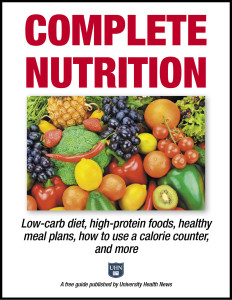How to Recognize High Cortisol Symptoms
The crippling effects of high cortisol symptoms are extremely common but all-too-often ignored. Cortisol is a vital hormone produced and secreted by the adrenal glands. It is released in a rhythmic fashion, with levels peaking in the morning (to help wake you up) and steadily declining throughout the remainder of the day.
What Is Cortisol?
Cortisol maintains steady blood sugar levels and helps provide energy to your actively functioning brain and neuromuscular system. It is also a potent anti-inflammatory hormone; it prevents the widespread tissue and nerve damage associated with inflammation.
Cortisol is also a key player in the stress response. Levels surge in response to physical or psychological threats to provide the energy necessary to cope with stressors or escape from danger. However, although a stress-induced increase in cortisol secretion is beneficial in the short-term, excessive or prolonged cortisol secretion may lead to high cortisol symptoms. The symptoms of high cortisol can have serious effects on both your body and your mind.
Eat Right, Starting Now!
Download this expert FREE guide, Complete Nutrition: Low-carb diet, high-protein foods, healthy meal plans, how to use a calorie counter, and more.
Create healthy meal plans and discover the Superfoods that can transform your plate into a passport to better health.
High Cortisol Symptoms
The symptoms of high cortisol develop gradually and mostly overlap with many other conditions and include[1-3]:
- Depression
- Fatigue
- Weight gain, especially in the face, upper back (“buffalo hump”), and torso
- Obesity, especially abdominal obesity/central obesity
- Back pain
- Thin skin
- Decreased concentration
- Swelling in the hands and feet
- Low libido
- Acne
- Impaired memory (especially short term)
- Female facial hair or female balding
- Insomnia
- Poor skin healing
- Irritability
- Menstrual abnormalities
- Blood sugar dysregulation/high blood sugar
- Decreased bone mineral density
- High blood pressure
- Easy bruising
- Muscle wasting and weakness of arms and legs
- Reddish purple streaks on skin
What Causes High Cortisol?
Rarely, high cortisol is caused by Cushing disease—a hormone-secreting tumor of the adrenal gland. More often, however, high cortisol is caused by prescription corticosteroid medications (including corticosteroid injections into the joints).[4]
Even more commonly, high cortisol is caused by chronic stress. Chronic stress dysregulates the body’s stress response system (the hypothalamic–pituitary-adrenal [HPA] axis). The HPA axis is a critical physiological system that mediates responses to all types of physical and psychological stress. When that stress is chronic, the delicate feedback system that is the HPA axis becomes damaged.[5] This can result in chronically high cortisol levels and lead to high cortisol symptoms.
Certain conditions are well known to cause the types of chronic physical and psychological stress that damage the HPA axis and lead to high cortisol levels. These conditions, which are often associated with high cortisol symptoms, include[6]:
- Depression
- Panic disorder
- Generalized anxiety disorder
- Posttraumatic stress disorder
- Anorexia nervosa
- Bulimia nervosa
- Alcoholism
- Diabetes mellitus
- Severe obesity
- Metabolic syndrome
- Polycystic ovary syndrome (PCOS)
- Obstructive sleep apnea syndrome
- Shift work
- End-stage kidney disease
- Major life stressors
- Chronic pain
What to Do About High Cortisol Symptoms
The fortunate news for those suffering from high cortisol is that many effective treatment options are available, including many natural cortisol-lowering therapies. The correct treatment depends on the underlying cause and may involve anything from surgical removal of the adrenal glands, in the case of true Cushing disease caused by an adrenal tumor, to diet and lifestyle therapies aimed at resetting the dysfunctional HPA axis.
If you’re suffering from high cortisol symptoms, eat at regular intervals (every few hours) and follow a diet that is higher in lean protein and fiber and lower in carbohydrates that have a high glycemic index (especially sugar). These dietary changes are important for lowering cortisol levels, as is the regular practice of relaxation or mind-body techniques such as meditation or progressive muscle relaxation.[7] Start by actively practicing one of these relaxation techniques just a few minutes a day and gradually increase the time to twenty to thirty minutes.
You can also supplement with natural compounds such as phosphatidylserine, magnolia bark extract, and ashwagandha root extract to help lower your cortisol levels. These supplements have been shown in clinical studies to lower high cortisol levels in chronically high-stressed individuals.[8-10]
To start, try phosphatidylserine supplementation at 600 to 800 mg per day; this amount has been shown to lower the cortisol response to acute stress, increase performance, improve mood, and lower feelings of stress.[11,12] These and other natural therapies are sure to lessen your stress response and lower your cortisol, helping you beat high cortisol symptoms for good.
Originally published in 2015, this post is regularly updated.
[1] J Clin Endocrinol Metab. 2008 May; 93(5): 1526–1540.
[2] Stress. 2015 Aug 13:1-9. [Epub ahead of print]
[3] Medscape Drugs and Diseases. Pseudo-Cushing Syndrome. Updated Oct. 2014. Accessed Aug. 22, 2015.
[4] Endocrine. 2015 Mar;48(2):410-6.
[5] BMB Rep. 2015 Apr; 48(4): 209–216.
[6] Endocrine. 2014 Aug;46(3):370-86.
[7] Stress Health. 2014 Feb;30(1):65-70.
[8] J Int Soc Sports Nutr. 2013 Aug 7;10(1):37.
[9] Indian J Psychol Med. 2012 Jul-Sep; 34(3): 255–262.
[10] Lipids Health Dis. 2014 Jul 31;13:121.
[11] Sports Med. 2006;36(8):657‐69.
[12] J Int Soc Sports Nutr. 2008 Jul 28;5:11.
The post How to Recognize High Cortisol Symptoms appeared first on University Health News.
Read Original Article: How to Recognize High Cortisol Symptoms »
Powered by WPeMatico



